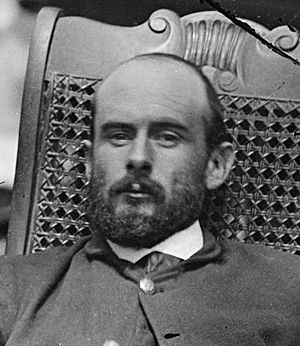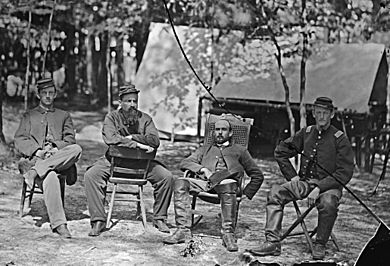Charles Francis Adams Jr. facts for kids
Quick facts for kids
Charles Francis Adams Jr.
|
|
|---|---|
 |
|
| President of Union Pacific Railroad | |
| In office 1884–1890 |
|
| Preceded by | Sidney Dillon |
| Succeeded by | Sidney Dillon |
| Personal details | |
| Born |
Charles Francis Adams Jr.
May 27, 1835 Boston, Massachusetts, U.S. |
| Died | March 20, 1915 (aged 79) Washington, D.C., U.S. |
| Resting place | Mount Wollaston Cemetery, Quincy, Massachusetts |
| Spouses |
Mary Hone Ogden
(m. 1865; until his death 1915) |
| Relations | See Adams family |
| Parents |
|
| Occupation | Soldier, railroad commissioner, park commissioner, author, historian |
| Signature | |
| Military service | |
| Allegiance | Union |
| Branch/service | Union Army |
| Years of service | 1861–1865 |
| Rank | |
| Unit | 1st Massachusetts Volunteer Cavalry |
| Commands | 5th Regiment Massachusetts Colored Volunteer Cavalry |
| Battles/wars | American Civil War: • Battle of Secessionville • Maryland Campaign • Battle of South Mountain • Battle of Antietam • Gettysburg Campaign • Battle of Aldie |
Charles Francis Adams Jr. (born May 27, 1835 – died March 20, 1915) was an important American writer and historian. He came from the famous Adams family, which included two U.S. presidents. Charles Jr. was the son of Charles Francis Adams Sr..
During the American Civil War, he served as a colonel in the Union Army. After the war, he worked to regulate railroads and later became a railroad executive. He also wrote many historical books and helped create parks in Massachusetts.
Contents
Growing Up and Family Life
Charles Francis Adams Jr. was born in Boston, Massachusetts, on May 27, 1835. His family had a long history of serving the public in America.
He was the great-grandson of U.S. President John Adams. He was also the grandson of President John Quincy Adams. His father, Charles Francis Adams Sr., was a lawyer, politician, and diplomat.
Charles Jr. had several siblings. These included his older brother, John Quincy Adams II, and his younger brothers, the famous historians Henry Adams and Brooks Adams.
He went to Harvard University and graduated in 1856. After that, he studied law and became a lawyer in 1858. Later, Harvard gave him an honorary law degree in 1895.
Serving in the Civil War
Charles Adams joined the Union Army during the American Civil War. He started as a first lieutenant in the 1st Massachusetts Volunteer Cavalry in December 1861. He was promoted to captain in December 1862.
He fought bravely during the Gettysburg Campaign. His company was heavily involved in the Battle of Aldie. In September 1864, his regiment's three-year service ended, and he left that unit.
Soon after, in September 1864, he became a lieutenant colonel in the 5th Massachusetts Cavalry. This regiment was made up of African American volunteer soldiers. He was promoted to colonel and took command of the regiment in March 1865, near the end of the war. His regiment was guarding Confederate prisoners of war in Maryland.
Adams wanted his regiment to fight in battles. He managed to get horses for them and had them moved to the front lines. He led his regiment into Richmond, Virginia, after it was captured in April 1865. He became ill and resigned from the Army in August 1865.
In 1866, he was given the honorary rank of brevet brigadier general. This was for his bravery and good service in battles like Secessionville, South Mountain, and Antietam.
Working with Railroads
After the Civil War, Charles Adams became very involved with railroads.
Helping Railroads in Massachusetts
He was appointed to the Massachusetts Railroad Commission. His goal was to encourage railroads to follow fair business rules. He believed that by making their practices public, companies would be embarrassed into doing better. This approach was sometimes called the "Sunshine Commission."
He wrote a book called Chapters of Erie about railroad issues. He thought that regulation was important to protect business owners and investors from unfair practices.
Leading the Union Pacific Railroad
In 1884, Congress asked Adams to become the new president of the Union Pacific Railroad (UP). He had many ideas for improving railroads, which he wrote about in his book Railroads, Their Origin and Problems.
As president, he worked to make the UP look good to the public. He even set up libraries along the railroad lines for his employees. However, he faced challenges, especially with worker unions. When a union refused extra work in Wyoming in 1885, Adams hired Chinese workers. This led to a sad event called the Rock Springs massacre, where many Chinese workers were killed.
Adams tried to create partnerships with other businesses, but these did not help the UP much. The railroad's financial situation got worse. In 1890, Jay Gould, who owned the railroad, asked Adams to resign.
Becoming a Historian
After 1874, Charles Adams spent a lot of his time studying American history. He became a respected historian.
He was elected to the American Academy of Arts and Sciences in 1871. He also became a member of the American Antiquarian Society in 1891.
In 1890, he became vice-president of the Massachusetts Historical Society. He was chosen as president of this society in 1895. He also became president of the American Historical Association in 1901. His writings and speeches on railroads and history often caused much discussion.
In 1875, he wrote an essay called "The Granger Movement." This essay showed how railroads were unfairly setting prices and creating monopolies. This helped lead to the Granger Laws, which aimed to regulate railroads.
Adams also wrote his autobiography, which was finished in 1912 and published after his death in 1916.
Helping the Community
Massachusetts Park Commission
From 1893 to 1895, Charles Adams led the Massachusetts Park Commission. He played a big part in planning the state's park system. He helped create important parks like the Blue Hills Reservation and the Middlesex Fells Reservation.
Supporting a Single Tax Idea
In 1900, he wrote a letter supporting an economic idea proposed by Henry George. This idea, later called Georgism, suggested a single tax on land value.
National Civic Confederation
In 1901, Adams represented the public on a board that helped settle disagreements between workers and businesses. This was part of the National Civic Confederation in New York City.
Family Life
On November 8, 1865, Charles Adams married Mary Hone Ogden (1843–1934). They had three daughters and twin sons:
- Mary Ogden Adams (born 1867)
- Louisa Catherine Adams (1872–1958)
- Elizabeth Ogden Adams (1873–1945)
- John Francis Adams (1875–1964)
- Henry Quincy Adams (1875–1951)
Death and Burial
Charles Francis Adams Jr. passed away on May 20, 1915. He is buried in Mount Wollaston Cemetery in Quincy, Massachusetts.
Works
- Chapters of Erie, and Other Essays (New York, 1871), with brother Henry Adams
- Railroads, Their Origin and Problems (New York, 1878)
- Notes on Railroad Accidents (New York, 1879)
- Richard Henry Dana: A Biography (Boston, 1890)
- Three Episodes of Massachusetts History (Boston, 1892)
- Massachusetts: Its Historians and Its History (Boston, 1893)
- Antinomianism in the Colony of Massachusetts Bay, 1636–1638 (1894).
- Charles Francis Adams (Boston and New York, 1900), in the American Statesmen series (biography of Charles Francis Adams Sr.)
- Lee at Appomattox, and Other Papers (1902)
- Reflex Light From Africa, The Century Magazine, vol. 72, pp. 101-111 (1906)
- Whence the Founders Travel (1907)
- Tis Sixty Years Since. Address of Charles Francis Adams, Founders' Day, January 16, 1913, University of South Carolina (New York, 1913)
- Charles Francis Adams, 1835–1915: An Autobiography (1916)
- Before and After the Treaty of Washington: The American Civil War and the War in the Transvaal. An address delivered before the New York Historical Society on its ninety-seventh anniversary, Tuesday, November 19, 1901 (New York, 1902)
Family tree
|
||||||||||||||||||||||||||||||||||||||||||||||||||||||||||||||||||||||||||||||||||||||||||||||||||||||||||||||||||||||||||||||||||||||||||||||||||||||||||||||||||||||||||||||||||||||||||||||||||||||||||||||||||||||||||||||||||||||||||||||||||||||||||||||||||||||||||||||||||||||||||||||||||||||||||||||||||||||||||||||||||||||||||||||||||||||||||||||||||||||||||||||||||||||||||||||||||||||||||||||||||||||||||||||||||||||||||||||||||||||||||||||||||||||||||||||||||||||||||||||||||||||||||||||||||||||||||||||||||||||||||||||||||||||||||||||||||||||||||
| Notes: | ||||||||||||||||||||||||||||||||||||||||||||||||||||||||||||||||||||||||||||||||||||||||||||||||||||||||||||||||||||||||||||||||||||||||||||||||||||||||||||||||||||||||||||||||||||||||||||||||||||||||||||||||||||||||||||||||||||||||||||||||||||||||||||||||||||||||||||||||||||||||||||||||||||||||||||||||||||||||||||||||||||||||||||||||||||||||||||||||||||||||||||||||||||||||||||||||||||||||||||||||||||||||||||||||||||||||||||||||||||||||||||||||||||||||||||||||||||||||||||||||||||||||||||||||||||||||||||||||||||||||||||||||||||||||||||||||||||||||||
See also
 In Spanish: Charles Francis Adams Jr. para niños
In Spanish: Charles Francis Adams Jr. para niños



